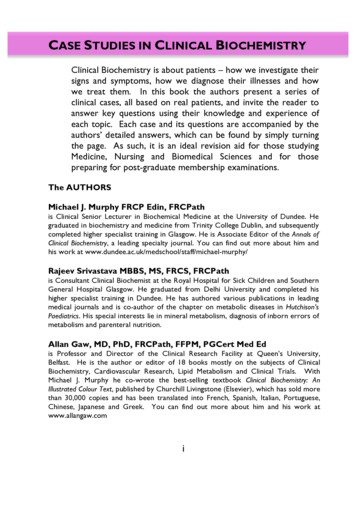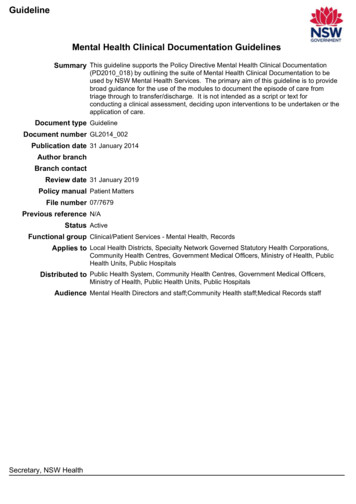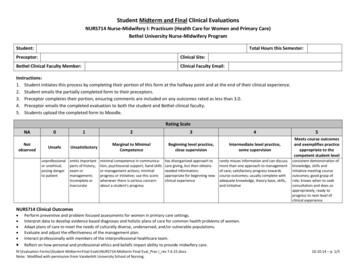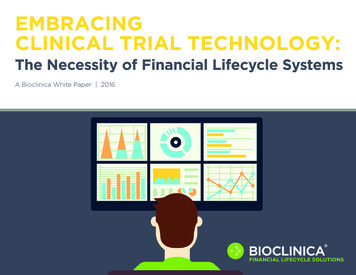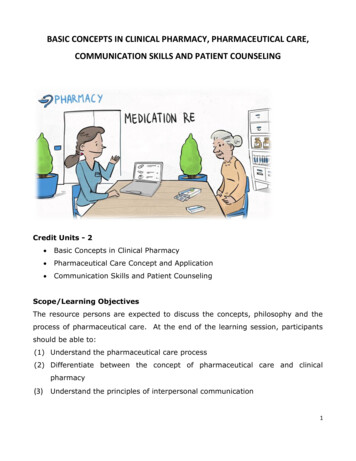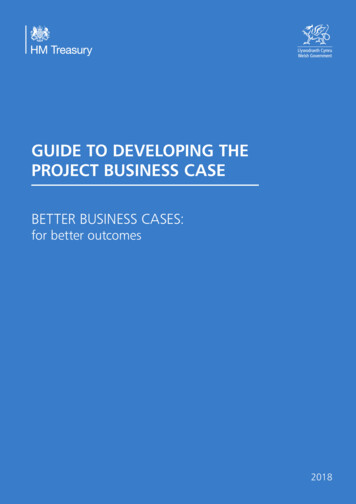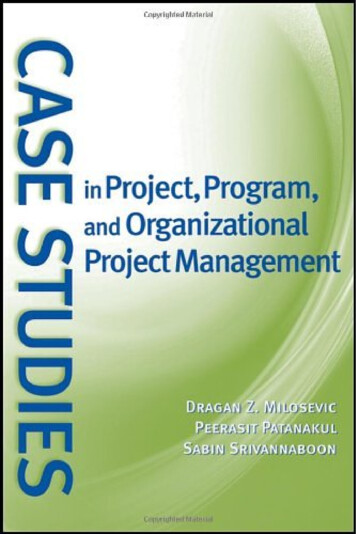
Transcription
Developing Clinical Case Studies: A Guide for TeachingSearch About Us / AETC Directory Clinician Resources Trainer Resources Topic Index AETC Only HomeGOTraining Topics Interactive Methods Case Studies Developing Clinical CasesDeveloping Clinical Case Studies: A Guide for Teaching Training Materials Training Principles Interactive Methods Program ManagementDate: 2003Editors: Ann Downer, MS, EdD and Sue Swindells, MBBSSource: AETC National Resource Center and International AIDS Society-USAThis guide was prepared for the AETC National Resource Center by the International AIDS Society-USA withfunding from the U.S. Health Resources Services Administration (HRSA). Copyright International AIDS SocietyUSA, 2003. Technology TopicsTable of ContentsEditor Information and DisclosureRelated ResourcesInternational AIDSSociety-USAPrint-friendly version ofdocumentIntroductionThe Value of Case StudiesSix Steps for Creating an Effective Case StudyStep 1. Identify the Learners and Write Educational ObjectivesStep 2. Describe the Patient and Develop Sufficient Case DetailStep 3. Focus the Learner on Discrete Clinical Decision PointsStep 4. Present Viable Options at Decision PointsStep 5. Analyze Options and Select One Course of ActionStep 6. Introduce New Information and Continue to Next Clinical Decision PointEffective Use of an Audience Response SystemResourcesCase SlidesCopyright 2007, the AIDS Education & Training Centers National Resource Center, unless otherwise noted. All rights reserved. Emailwebmaster@aidsetc.org with questions, comments, or problems. See disclaimer for usage guidelines.http://www.aids-ed.org/aidsetc?page et-cases-toc10/4/2007 6:08:53 PM
Editor Information and DisclosureSearch About Us / AETC Directory Clinician Resources Trainer Resources Topic Index AETC Only HomeGOTraining Topics Interactive Methods Case Studies Developing Clinical Cases Editor InformationContentsPAGE NAVIGATIONAnn Downer, MS, EdDSue Swindells, MBBSEditor Information and DisclosureAnn Downer, MS, EdDAnn Downer, MS, EdD, is the Executive Director of the Center for Health Education and Research, and the CoDirector of the International Training and Education Center on HIV at the University of Washington School ofPublic Health and Community Medicine and the School of Medicine in Seattle, Washington.Dr. Downer has no affiliations with commercial organizations that may have interest related to the content of thisarticle.Sue Swindells, MBBSSusan Swindells, MBBS, is the Terry K. Watanabe Professor and Medical Director of the HIV Clinic at theUniversity of Nebraska Medical Center in Omaha, Nebraska.Dr. Swindells has received research grants or contract/honorarium from Agouron Pharmaceuticals, Bristol-MyersSquibb, and Glaxo Smith Kline. She has also received a research grant or contract from The DupontPharmaceutical Company and Novartis Pharmaceuticals Corporation.Copyright 2007, the AIDS Education & Training Centers National Resource Center, unless otherwise noted. All rights reserved. Emailwebmaster@aidsetc.org with questions, comments, or problems. See disclaimer for usage guidelines.http://www.aids-ed.org/aidsetc?page et-cases-editors10/4/2007 6:09:25 PM
IntroductionSearch About Us / AETC Directory Clinician Resources Trainer Resources Topic Index AETC Only HomeGOTraining Topics Interactive Methods Case Studies Developing Clinical Cases IntroductionContentsIntroductionValue of Case StudiesSix Steps for Creating CaseStudiesAudience Response SystemsCase SlidesIntroductionDeveloping Clinical Case Studies: A Guide for Teaching is designed to assist health care practitioners withdevelopment of case studies for teaching in continuing medical education (CME) and similar educationalsituations. The guide uses brief descriptions and examples to lead the reader/educator through the steps ofstructuring a teaching case to address specific educational objectives. The process for developing interactivecase studies for the purpose of teaching includes 6 steps:Identify the learners and write educational objectivesDescribe the patient and develop sufficient case detailFocus the learner on discrete clinical decision pointsPresent viable options at decision pointsAnalyze options and select one course of actionIntroduce new information and continue to next clinical decision point1A sample case study involving a patient with HIV infection and substance abuse is presented throughout theguide to illustrate the case-building process.Case studies are widely used to complement and enliven didactic educational material and they can be adaptedfor a variety of teaching situations. The example case study used in this guide is presented as a series of slidesor overhead transparencies. The case is designed to be presented to a group of learners and to solicit audienceresponse to specific multiple choice questions. Audience response can be obtained through a variety ofapproaches, including by discussion, by a show of hands, by voting with colored cards, or, if available, throughthe use of a computerized audience response system.Case studies also can be used in other educational formats to complement didactic information. In a small groupsetting, a presenter can describe a case without any audiovisual tools and can lead the audience to recommendclinical options for discussion, rather than using structured multiple choice responses. In training workshops,case studies can be used for role-playing activities designed to focus on patient/provider interaction. Self-studyeducational activities, such as Web-based interactive programs, also effectively use case studies. Problembased learning, a teaching method that is being more widely used in continuing medical education, involvesdistributing case studies to learners and having them individually research the relevant clinical information.References1. Adapted from Friedland GH. HIV therapy in "triple-diagnosed" patients: HIV infection, drug use, and mentalillness. Cases on the Web [International AIDS Society-USA online CME series]. 2002. Available at http://www.iasusa.org/cow. Accessed May 15, 2003.Next: The Value of Case StudiesCopyright 2007, the AIDS Education & Training Centers National Resource Center, unless otherwise noted. All rights reserved. Emailwebmaster@aidsetc.org with questions, comments, or problems. See disclaimer for usage guidelines.http://www.aids-ed.org/aidsetc?page et-cases-I10/4/2007 6:09:36 PM
The Value of Case StudiesSearch About Us / AETC Directory Clinician Resources Trainer Resources Topic Index AETC Only HomeGOTraining Topics Interactive Methods Case Studies Developing Clinical Cases Value of Case StudiesContentsThe Value of Case StudiesIntroductionValue of Case StudiesSix Steps for Creating CaseStudiesAudience Response SystemsIn recent meta-analyses of the effectiveness of CME programs in changing physician behavior, several keyfactors are associated with successful outcomes. These include (1) the assessment of learning needs; (2)interaction among learners with opportunities to practice the behaviors; and (3) sequenced and multifaceted1 2educational activities. , In general, interactive and mixed (didactic/interactive) educational sessions have themost significant effect on professional practice.Case SlidesThere are 2 main types of case studies: (1) fully developed narrative approaches to guide learners through anextended discussion and exploration process; and (2) shorter case presentations that offer critical information atspecific points in decision-making. The former is used primarily for social studies and liberal arts and the latter isused widely in medical education.All case-based teaching methods bring value to education and in general are more interesting for the learnerthan completely didactic material. Cases offer an opportunity to develop learners' analytical and problem-solvingskills and allow for the pragmatic application of new knowledge and skills to challenging situations. All of these3are higher-level learning skills. However, in order for the case discussion to facilitate learning, the case must berelevant to the learner and must contain sufficient information to lead the learner to an appropriate conclusion orresult.Clinical case studies are designed to represent actual patient encounters or a series of patient encounters. Bypresenting clinical issues in the context of a patient's situation, case studies are an effective tool fordemonstrating clinical decision-making. Case studies are widely used in teaching diagnostic and managementskills to medical students and in CME activities.Case-based teaching is a valuable strategy in all areas of clinical education, and it is particularly valuable foreducating practitioners about HIV disease. It is essential for practitioners to be able to individualize care giventhe complexity and chronic nature of HIV disease, the number of opportunistic infections and related conditions,the range of treatment options for each, and the high pill burden and consistent adherence required for effectiveanti-HIV therapy.The case example used throughout this guide follows a man with active heroin addiction who has beenhospitalized with Pneumocystis carinii pneumonia (PCP; also known as Pneumocystis jiroveci pneumonia). Thispatient's drug addiction and unstable social and economic circumstances influence the direction of treatment, asoften happens in a real clinical setting. Immediate feedback on a treatment decision made in the context of acase study prepares practitioners to work more effectively with patients.References1. Mazmanian PE, Davis DA. Continuing medical education and the physician as learner: guide to theevidence. JAMA. 2002;288:1057-1060.2. Davis D, O'Brien MA, Freemantle N, Wolf FM, Mazmanian P, Taylor-Vaisey A. Impact of formal continuingmedical education: do conferences, workshops, rounds, and other traditional continuing education activitieschange physician behavior or health care outcomes? JAMA. 1999;282:867-874.3. Bloom BS, Engelhart MD, Furst EJ, Hill WH, Krathwohl DR. Taxonomy of Educational Objectives: TheClassification of Educational Goals. Handbook 1: The Cognitive Domain. New York: David McKay; 1956.http://www.aids-ed.org/aidsetc?page et-cases-II (1 of 2)10/4/2007 6:09:50 PM
The Value of Case StudiesTip Box 1. Tips for Presenting Effective Case Study Slide PresentationsIn general, allow 1 minute per slide (eg, for a 30-minute presentation, use fewerthan 30 slides)Plan strategic pauses to allow for discussion and audience voting; use "pause"slide(s) to remind yourselfBe prepared to expand the case discussion by suggesting a new developmentor a different situationNext: Six Steps for Creating an Effective Case Study: Step 1. Identify the Learners and Write EducationalObjectivesCopyright 2007, the AIDS Education & Training Centers National Resource Center, unless otherwise noted. All rights reserved. Emailwebmaster@aidsetc.org with questions, comments, or problems. See disclaimer for usage guidelines.http://www.aids-ed.org/aidsetc?page et-cases-II (2 of 2)10/4/2007 6:09:50 PM
Six Steps for Creating an Effective Case StudySearch About Us / AETC Directory Clinician Resources Trainer Resources Topic Index AETC Only HomeGOTraining Topics Interactive Methods Case Studies Developing Clinical Cases Step 1: Educational ObjectivesContentsIntroductionValue of Case StudiesSix Steps for Creating anEffective Case StudyStep 1Step 2Step 3Six Steps for Creating an Effective Case StudyStep 1. Identify the Learners and Write Educational ObjectivesThe development of effective educational material begins with consideration of the learner and his or herlearning needs. Needs assessment identifies specific issues that may be challenging, confusing, or controversialto learners. See Table 1 for tips on assessing learners in advance of the teaching session or on-the-spot. If anopportunity does exist to assess learners in advance, it can be accomplished with a short questionnaire, e-mailcorrespondence, or brief interviews with those planning to participate in the educational activity.Step 4Step 5Step 6Audience Response SystemsCase SlidesTable 1. Needs Assessment: Learn More About Your AudienceDuring the planning phaseSend an email query to those likely to attend a session (ask 2-3 key questions)Make a 10-minute phone call with several probable attendeesHave a discussion with a key informant about the group's general characteristicsWrite a formal, short needs-assessment questionnaireOn the spot:As the presentation begins ask a few key questions; use a show of hands or an ARSWhat is your educational training (MD, RN, NP, PA, etc)?How many years have you been an HIV care practitioner?What percent of your caseload is HIV-related?Do you work with patients with HIV infection and substance abuse? Injection drug use?The focus of the case will depend on learners and on the specific skills relevant to their medical practice. Forexample, in the case study used to illustrate this guide, a patient with active substance abuse problems isadmitted to the hospital through the emergency department with a diagnosis of PCP. The first clinical decisionpoint the learner is asked to make concerns the discharge plan. The elements of the discharge plan of greatestconcern to social workers are different from those of concern to an audience of HIV physicians. The focus of thecase, therefore, depends on the needs and interests of the learners.The actual design of a case begins with the creation of specific learning objectives once the learners and topicare defined. It is often more difficult to design objectives to fit an existing patient case scenario than to start withlearning objectives and build a new case around them. The specific objectives of the case should be identifiedeven if the case is not part of an activity that carries CME credit (which requires the publication of objectives).1Learning objectives are words, pictures or diagrams that tell others what you intend for your students to learn.The purpose of writing strong learning objectives is to make explicit the expected outcomes of a learning eventand to establish accountability between the instructor and learner. Specific measurable objectives are essentialfor determining outcomes in the activity evaluation. Table 2 describes the elements of strong objectives andhttp://www.aids-ed.org/aidsetc?page et-cases-III-1 (1 of 2)10/4/2007 6:10:03 PM
Six Steps for Creating an Effective Case StudyTable 3 provides a detailed taxonomy for learning objectives.Table 2. Writing Strong ObjectivesStrong objectives are specific. They are constructed by stating a performance that describes specificknowledge, attitudes, or skills that a student should be able to demonstrate following exposure to alearning activity. They do not describe the teaching strategy used to achieve a learning outcome.Strong objectives are measurable. They use active verbs that can be measured by test items,observation, problem-solving exercises, or other evaluation methods. If the performance behavior iscovert (will recognize, will identify), then an indicator behavior (will recognize by circling, will identify byunderlining) should be stated. See Table 3 for a list of measurable verbs for assessing achievement.Strong objectives are achievable and realistic. They describe expectations of knowledge, attitude, orbehavior change that are realistic given the conditions for instruction (ie, time and size of the group).1Adapted from Mager .A case study should have more than one objective. Often a series of objectives are addressed as the caseunfolds. The clinical decision points of the case focus on the issues identified in the objectives. The case studyincluded in this guide was designed to address the issue of HIV treatment for patients with drug addiction. Thespecific educational objectives are listed in Slide 1.References1. Mager RF. Preparing Instructional Objectives. Atlanta: Center for Effective Performance, Inc.; 1997.Next: Step 2. Describe the Patient and Develop Sufficient Case DetailCopyright 2007, the AIDS Education & Training Centers National Resource Center, unless otherwise noted. All rights reserved. Emailwebmaster@aidsetc.org with questions, comments, or problems. See disclaimer for usage guidelines.http://www.aids-ed.org/aidsetc?page et-cases-III-1 (2 of 2)10/4/2007 6:10:03 PM
Six Steps for Creating an Effective Case StudySearch About Us / AETC Directory Clinician Resources Trainer Resources Topic Index AETC Only HomeGOTraining Topics Interactive Methods Case Studies Developing Clinical Cases Step 2: Describe PatientContentsIntroductionSix Steps for Creating an Effective Case StudyStep 2. Describe the Patient and Develop Sufficient Case DetailValue of Case StudiesSix Steps for Creating anEffective Case StudyStep 1The first part of a case description provides baseline information on the patient and moves the learner towardthe first clinical decision point. Key baseline information may include age, sex, HIV infection status, reportedsymptoms at presentation, recent medical history, relevant social history, findings from physical examination,results of laboratory studies, and findings of diagnostic workup.Step 2Step 3Step 4The number of elements included in the case description depends on the complexity of the case and theinformation needed to stage the decision point.Step 5Tip Box 2. Tips for Creating Effective SlidesStep 6Audience Response SystemsGive each slide a title. Titles help the audience quickly understandthe main themeCase SlidesUse as few words as possible to convey your point; help theaudience focus on key pointsMake your text large. Use titles with a minimum 36-point type sizeand text with a minimum 24-point type size. Do not use a slide thatthe audience cannot readUse no more than eight words per line of text and no more than sixlines of text on each slideMinimize detail on tables and figuresChoose strong color contrast between the background and the text.Use light background color for a poorly lit room and dark backgroundfor a brightly lit roomText drop shadows should be black or a darker shade of thebackground colorIn general, the information should be as brief as possible while providing enough detail for the learner to makean informed clinical decision. Slides 2 and 3 describe a patient's substance dependence, HIV status, and PCPtreatment in brief but sufficient detail. The information provided is minimal but varied enough to supportdiscussion of a number of common clinical issues, such as adherence to antiretroviral therapy in activesubstance users and potential drug-drug interactions between heroin or methadone and antiretroviral drugs.http://www.aids-ed.org/aidsetc?page et-cases-III-2 (1 of 3)10/4/2007 6:10:20 PM
Six Steps for Creating an Effective Case StudyIt is important to provide enough information for the learners to make a decision. The patient description shownin Slide 4, if used alone, would not be sufficient to support a clinical decision point. Key information is missing,such as CD4 cell count and viral load data, as well as any substance abuse or other health issues.Next: Step 3. Focus the Learner on Discrete Clinical Decision Pointshttp://www.aids-ed.org/aidsetc?page et-cases-III-2 (2 of 3)10/4/2007 6:10:20 PM
Six Steps for Creating an Effective Case StudyCopyright 2007, the AIDS Education & Training Centers National Resource Center, unless otherwise noted. All rights reserved. Emailwebmaster@aidsetc.org with questions, comments, or problems. See disclaimer for usage guidelines.http://www.aids-ed.org/aidsetc?page et-cases-III-2 (3 of 3)10/4/2007 6:10:20 PM
Six Steps for Creating an Effective Case StudySearch About Us / AETC Directory Clinician Resources Trainer Resources Topic Index AETC Only HomeGOTraining Topics Interactive Methods Case Studies Developing Clinical Cases Step 3: Focus on Decision PointsContentsIntroductionSix Steps for Creating an Effective Case StudyStep 3. Focus the Learner on Discrete Clinical Decision PointsValue of Case StudiesSix Steps for Creating anEffective Case StudyStep 1Step 2Step 3Step 4Once the baseline information has been presented, the case study moves toward a clinical decision point. Thepurpose of the decision point is to focus learners' attention on discrete opportunities for informed decisionmaking. It is important to develop a well-defined question that addresses an educational objective. In the caseexample, Darrel is being discharged from the hospital after treatment for PCP, and the learner is asked to selecta recommended discharge plan (see Slide 5). The learning objective for this clinical decision point anticipatesthat the learner will be able to "design a care plan that offers treatment and suppport for patients withcomorbities (OI, substance abuse, HIV)".Step 5Step 6Audience Response SystemsCase SlidesIf an additional educational objective had specified that the learner will be able to "select an initial antiretroviralregimen for a patient with substance dependence," then the clinical decision point could be redirected (see Slide6 ). In this slightly different patient description, a stable living situation and drug treatment have been arranged,and the elements of the clinical decision change. Instead of focusing the decision on the types of treatment tosupport the patient upon discharge, the learner could choose among different antiretroviral regimens and weighspotential drug-drug interactions, adverse effects, and adherence challenges.http://www.aids-ed.org/aidsetc?page et-cases-III-3 (1 of 2)10/4/2007 6:10:37 PM
Six Steps for Creating an Effective Case StudyNext: Step 4. Present Viable Options at Decision PointsCopyright 2007, the AIDS Education & Training Centers National Resource Center, unless otherwise noted. All rights reserved. Emailwebmaster@aidsetc.org with questions, comments, or problems. See disclaimer for usage guidelines.http://www.aids-ed.org/aidsetc?page et-cases-III-3 (2 of 2)10/4/2007 6:10:37 PM
Six Steps for Creating an Effective Case StudySearch About Us / AETC Directory Clinician Resources Trainer Resources Topic Index AETC Only HomeGOTraining Topics Interactive Methods Case Studies Developing Clinical Cases Step 1: Educational ObjectivesContentsIntroductionSix Steps for Creating an Effective Case StudyStep 4. Present Viable Options at Decision PointsValue of Case StudiesSix Steps for Creating anEffective Case StudyStep 1Step 2It is important to present a number of relevant, mutually exclusive decision options to the learners. Each choiceshould be comparable to the others in terms of importance, plausibility, and level of detail. In Slide 7, forexample, the options to choose from are balanced and most address the 3 key elements of the discharge plan:PCP treatment, follow-up HIV care, and substance abuse treatment. While there is often no "right" answer, thereshould be a clearly "preferred" answer.Step 3Step 4Step 5Step 6Audience Response SystemsCase SlidesIf, as described in Slide 6, the focus of the clinical decision point had been to select among treatment regimens,the options to choose from would be a list of antiretroviral drug combinations.http://www.aids-ed.org/aidsetc?page et-cases-III-4 (1 of 2)10/4/2007 6:10:48 PM
Six Steps for Creating an Effective Case StudyIt is important to create options that are grammatically similar and of roughly the same length. For example, theoptions are comparable in length on Slide 7. The longest option in a multiple choice set is often the preferredone because there is a natural tendency to explain and rationalize the preferred response in greater detail to thelearner. This tendency is illustrated in Slide 8. It is also useful to avoid including the options "all of the above"and "none of the above" in multiple choice response sets. Instead, provide the learner with concrete, discretechoices.Next: Step 5. Analyze Options and Select One Course of ActionCopyright 2007, the AIDS Education & Training Centers National Resource Center, unless otherwise noted. All rights reserved. Emailwebmaster@aidsetc.org with questions, comments, or problems. See disclaimer for usage guidelines.http://www.aids-ed.org/aidsetc?page et-cases-III-4 (2 of 2)10/4/2007 6:10:48 PM
Six Steps for Creating an Effective Case StudySearch About Us / AETC Directory Clinician Resources Trainer Resources Topic Index AETC Only HomeGOTraining Topics Interactive Methods Case Studies Developing Clinical Cases Step 5: Analyze OptionsContentsIntroductionSix Steps for Creating an Effective Case StudyStep 5. Analyze Options and Select One Course of ActionValue of Case StudiesSix Steps for Creating anEffective Case StudyStep 1Step 2In Step 5, the instructor identifies the preferred response from among the multiple choices once learners havehad a chance to consider (and possibly vote on) the alternatives. At this point, the case study presentationusually includes a brief lecture segment supporting the relevant clinical issues related to the preferred response.If available, new developments and current data supporting the preferred choice are presented. The current dataare discussed in the context of the patient's situation, and the various options are contrasted and weighed.Step 3Step 4Step 5Step 6Slides 9 and 10 illustrate 2 formats for presenting a preferred option. Slide 9 presents only the preferred optionand provides a brief rationale for it. Slide 10 shows the preferred option highlighted to stand out among all theother options.Audience Response SystemsCase Slideshttp://www.aids-ed.org/aidsetc?page et-cases-III-5 (1 of 3)10/4/2007 6:10:59 PM
Six Steps for Creating an Effective Case StudySlides 11 and 12 list a number of factors that support the decision on how care was prioritized for this patient.The discussion could expand on any of these topics. If, as discussed above, the clinical decision point focusedon selecting a specific antiretroviral regimen, these slides could present data on drug characteristics andpotential interactions with methadone and heroin.An important part of presenting the preferred response in Step 5 is the discussion and review of alternativehttp://www.aids-ed.org/aidsetc?page et-cases-III-5 (2 of 3)10/4/2007 6:10:59 PM
Six Steps for Creating an Effective Case Studyoptions. This is an opportunity to present data and demonstrate the decision-making process. Slide 13 illustratesone format for presenting each of the options not selected, accompanied by a brief explanation of why, in thecontext of this case study, another strategy is preferred.Next: Step 6. Introduce New Information and Continue to Next Clinical Decision PointCopyright 2007, the AIDS Education & Training Centers National Resource Center, unless otherwise noted. All rights reserved. Emailwebmaster@aidsetc.org with questions, comments, or problems. See disclaimer for usage guidelines.http://www.aids-ed.org/aidsetc?page et-cases-III-5 (3 of 3)10/4/2007 6:10:59 PM
Six Steps for Creating an Effective Case StudySearch About Us / AETC Directory Clinician Resources Trainer Resources Topic Index AETC Only HomeGOTraining Topics Interactive Methods Case Studies Developing Clinical Cases Step 6: New InformationContentsIntroductionSix Steps for Creating an Effective Case StudyStep 6. Introduce New Information and Continue to Next Clinical Decision PointValue of Case StudiesStep 1Step 2The previous steps describe 1 cycle of a case study through the resolution of a clinical decision point. The casecan be used in its current length as a short vignette, or it can be moved toward a second decision point on thesame patient.Step 3Step 4Step 5Step 6Audience Response SystemsCase SlidesDarrel's case can continue with new information from a follow-up appointment (eg, ongoing symptoms, adverseeffects of medication, or laboratory results), leading the learner to another clinical decision point. These pointscan be designed to address either the same or different educational objectives. Slide 14 describes the nextencounter with Darrel in the case study, and sets the stage for the second clinical decision point on Slide 15.The patient now has entered a methadone treatment program and attended an HIV clinic. Although his livingsituation remains unstable, he is interested in starting antiretroviral therapy. The treatment recommendationoptions listed on Slide 16 lead the discussion to adherence issues among substance users. One option is to setand meet an adherence goal before beginning HAART, such as getting a note on attendance from themethadone clinic, attending three HIV clinic appointments, or completing a trial drug regimen with jelly beans.http://www.aids-ed.org/aidsetc?page et-cases-III-6 (1 of 3)10/4/2007 6:11:10 PM
Six Steps for Creating an Effective Case StudyThe issue of adherence in substance users is likely to spark controversy and debate among the audience andevoke personal and professional attitudes toward substance users. This example demonstrates the importanceof good facilitation skills in addition to traditional teaching/instructing skills. Inexperienced instructors make twocommon mistakes in facilitating discussion. They sometimes fail to provide the direction and leadership that alearning group needs or they become over-involved in the discussion and unable to maintain the critical role offacilitator. Some facilitation strategies are offered in Table 4.One benefit of following a single patient through a number of decision points is that it allows an audience orlearner to quickly assimilate new information since the patient history is already known. Use of a continuing casereflects realistic dynamics of patient care. However, shorter vignettes with 1 or 2 brief decisions points haveadvantages, too. They may move a learner quickly through a variety of clinical situations.Table 4. Strategies for Optimizing Group Discussionhttp://www.ai
Case studies are widely used in teaching diagnostic and management skills to medical students and in CME activities. Case-based teaching is a valuable strategy in all areas of clinical education, and it is particularly valuable for educating practitioners about HIV disease. It is essential

